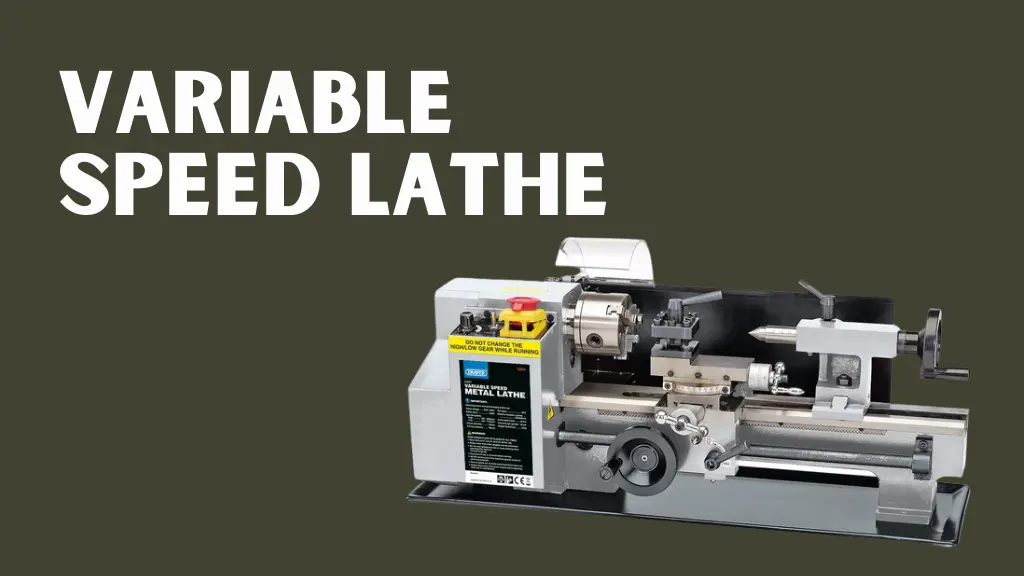A lathe has long been one of the most essential tools in both woodworking and metalworking. With advancements in technology, these machines have become more adaptable, efficient, and precise over time. Among the available options, the variable speed lathe stands out as a popular choice for both professionals and hobbyists. Its ability to adjust spindle speeds instantly makes it ideal for a wide range of applications, from intricate woodturning projects to demanding industrial machining tasks.
This guide will walk you through everything you need to know about these machines. We’ll cover how they work, their core benefits, the industries that rely on them, and real-world examples of their effectiveness. You’ll also find practical tips to help you choose the right model, ensuring it meets your specific needs whether you’re a beginner, a hobbyist, or an experienced machinist.
What is a Variable Speed Lathe?
A variable speed lathe is a machine designed to rotate a workpiece while giving the operator easy control over spindle rotation speed. Unlike traditional models that rely on manual belt changes or gear adjustments, these machines feature electronic controls for seamless speed shifts. With just a dial turn or button press, users can fine-tune settings without interrupting their workflow, making the process more efficient and precise.
This adaptability is important because every material and project has unique requirements. For instance, softwoods often need higher RPMs for smooth shaping, while metals or dense hardwoods perform better at slower, controlled speeds. By offering this range of flexibility, the machine ensures better finishes, improved safety, and consistent results across woodworking, metalworking, and industrial applications.
How Variable Speed Works
Instead of mechanical belt shifting, adjustable speed lathes rely on electronic controls powered by inverter drives, also known as variable frequency drives (VFDs). These drives regulate the electrical frequency supplied to the motor, allowing instant adjustments without stopping the machine. This eliminates the need for manual belt changes, saving time during projects. It also gives operators more flexibility when working with different materials.
This modern technology ensures smooth transitions between speeds and delivers stronger torque at lower RPMs. For machinists, a variable speed lathe provides precise control, which results in cleaner cuts and reduced vibration. The improved stability also enhances surface finishes, making the end product more professional. Over time, this reliability translates into both efficiency and cost savings in workshops.
Advantagesof Using a Variable Lathe
One of the main advantages of an adjustable speed lathe is its adaptability, but that’s just the beginning. These machines are designed to handle different materials and project types with ease, giving both professionals and hobbyists more control over their work. The ability to shift speeds smoothly without halting operations makes them highly efficient in busy workshops.
Safety is another key benefit. With precise speed control, the risk of tool chatter, material damage, or user mistakes is greatly reduced. This not only protects the operator but also improves the overall quality of the finished product. At the same time, accuracy is enhanced, as fine-tuning spindle speeds leads to cleaner cuts and smoother surfaces.
Durability and cost-effectiveness also set these machines apart. Electronic drives minimize wear on mechanical parts, extending the lifespan of the equipment. And while the initial investment may be higher, the long-term savings from reduced maintenance and greater efficiency often outweigh the upfront costs, making them a smart choice for many workshops.
Real-World Applications
Modern lathes have become essential tools across a wide range of industries and workshops because of their adaptability. Their flexibility makes them suitable for everything from small creative projects at home to complex, high-precision manufacturing tasks in professional settings. By offering speed adjustments at the touch of a dial, these machines simplify operations and reduce the downtime typically associated with belt-driven systems.
In woodworking, they give turners the ability to experiment with bowls, pens, and furniture components without repeatedly reconfiguring the machine. A woodworker moving between soft pine and dense maple, for example, can make quick speed changes on the same project, leading to cleaner cuts and better finishes. This convenience encourages creativity and efficiency while ensuring consistent results.
Metalworking applications highlight another layer of their value. Machinists benefit from precise speed control when working with materials like stainless steel, aluminum, or brass. A mechanical workshop in Houston documented a 15% reduction in production time after upgrading to newer models, showing how technology directly supports productivity. For hobbyists, the ease of use lowers the learning curve, allowing beginners to focus on improving their craft without being discouraged by complicated gear systems.
Choosing the Right Machine
When purchasing a variable speed lathe, one of the first considerations should be size and capacity. Smaller bench-top versions are excellent for hobbyists or those working in compact workshops, while larger, floor-standing industrial models are designed to handle bigger and heavier workpieces. Another critical factor is the machine’s speed range. A lathe with a wide RPM spectrum allows the user to adapt easily to different materials, from softwoods and plastics to harder metals, without compromising on finish or accuracy.
Motor strength also plays a key role in overall performance. A powerful motor ensures that the machine can manage tougher materials consistently without slowing down or overheating. Build quality goes hand in hand with this cast-iron frames or heavy-duty construction reduce vibration and keep the lathe stable, which is especially important when working on detailed or high-precision tasks. A solid frame not only improves accuracy but also contributes to the machine’s long-term durability.
Beyond technical specifications, brand reputation and user feedback provide valuable guidance. Established manufacturers typically offer reliable after-sales service, easy access to spare parts, and multi-year warranties that reflect confidence in their machines. Checking reviews can also be revealing—many professional-grade models earn ratings of 4.7 stars or higher, with hundreds of users praising their consistent performance, durability, and ease of use. Taking the time to weigh these factors ensures that your investment delivers lasting value.
Expert Insight
With years of experience in both woodworking and machining, I’ve seen how modern speed control can completely change the workflow. On older, belt-driven machines, changing speeds meant stopping the project, adjusting pulleys, and recalibrating tools. This process not only slowed down productivity but often introduced small errors that affected precision and finish quality.
In contrast, electronic adjustment systems allow changes in seconds without interrupting the work. For professionals, this efficiency translates into higher output and more consistent results. For beginners, the ease of use reduces frustration, builds confidence, and encourages them to experiment with different techniques—making the machine valuable for both learning and professional-grade projects.
Maintenance and Longevity
Like all workshop machinery, a variable speed machine requires regular care to deliver peak performance and a long lifespan. Routine tasks such as lubrication, cleaning, and calibration play a critical role in ensuring smooth operation. Unlike traditional belt-driven systems, these models often demand less mechanical upkeep because they contain fewer moving parts, which reduces wear and tear over time.
To further enhance durability, many professionals recommend using dust collection systems and protective covers that prevent debris buildup. Manufacturers also advise periodic servicing of electronic drives to maintain consistent performance. Backed by warranties and positive reviews from experienced users, these practices reflect not only the reliability of the machine but also the importance of preventive maintenance in sustaining precision and safety across years of use.
Industry Adoption
More industries are embracing advanced lathes because of their adaptability and precision. Training centers and schools integrate them into their programs to provide students with hands-on machining experience, while furniture makers depend on them to deliver consistent, high-quality production. In heavy industries, such as aerospace and automotive, large-scale models are trusted for complex tasks that demand accuracy and efficiency.
This widespread adoption reflects a clear shift toward smarter, digitally controlled equipment in modern workshops. By combining reliability with innovation, these machines are not only streamlining workflows but also preparing the next generation of machinists for the technology-driven future of manufacturing.
Common Misconceptions
Some people assume these machines are too advanced or only suited for seasoned machinists. However, real workshop experiences show they are often more user-friendly than traditional belt-driven models. Beginners find them easier to operate because speed adjustments can be made instantly without complex gear changes, allowing them to focus on learning techniques rather than struggling with the setup.
Another common misconception is that the electronic components are fragile. In reality, leading manufacturers design their equipment with industrial-grade parts, tested under heavy-duty conditions and supported by long-term warranties. Reviews from professionals and hobbyists highlight their reliability, proving that a properly maintained model can deliver years of consistent performance while maintaining precision and safety.
Conclusion
The variable speed lathe has redefined how professionals and hobbyists approach machining tasks. Its ability to deliver instant speed adjustments not only improves precision but also enhances safety and efficiency in the workshop. From woodturners creating delicate designs to machinists handling heavy-duty projects, users consistently highlight the difference in quality and time savings compared to traditional belt-driven machines.
Industry experts back this view, noting that reputable brands offer models with durable builds, powerful motors, and strong customer support. Many units are rated highly by verified buyers, reflecting real-world trust and satisfaction. For anyone committed to long-term performance and professional-grade results, investing in this technology offers both reliability and lasting value.
FAQs
What is the difference between a fixed speed and a variable lathe?
A fixed speed lathe operates at preset speeds and requires manual changes to adjust. A variable speed machine allows instant adjustments using electronic controls, offering more convenience and flexibility.
Are these modern lathes worth the investment?
Yes. While they may cost more initially, the time savings, improved accuracy, and reduced maintenance often make them a worthwhile investment.
Is this type of lathe suitable for beginners?
Absolutely. Beginners benefit from easier controls, making it a great choice for learning and small projects.
How long do these machines last?
With proper care and regular servicing, these machines can remain reliable for several decades. Many top manufacturers support this longevity with multi-year warranties and strong customer service.




